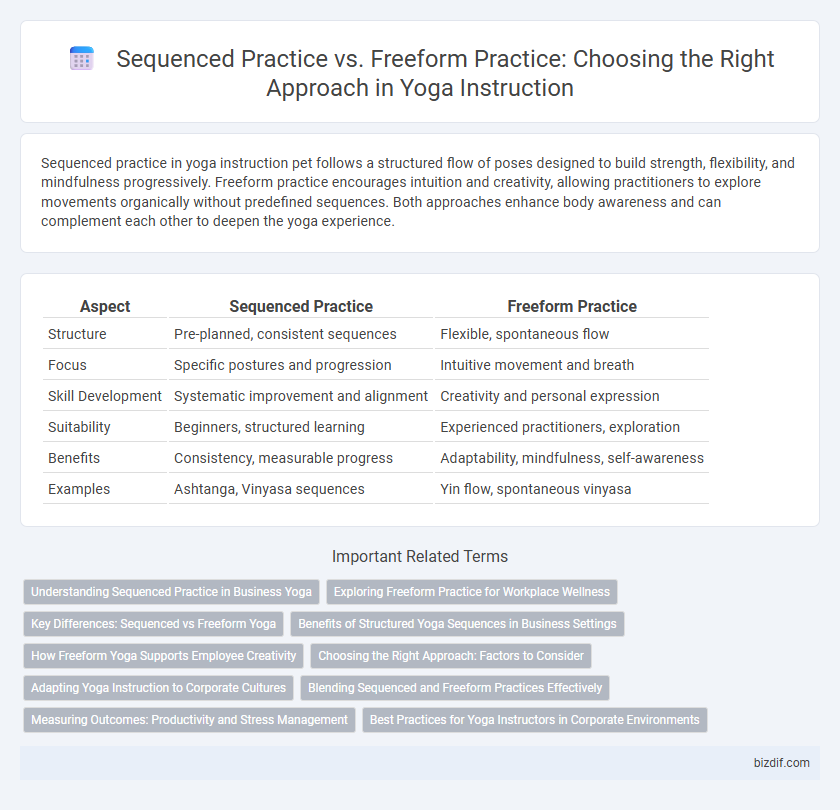Sequenced practice in yoga instruction pet follows a structured flow of poses designed to build strength, flexibility, and mindfulness progressively. Freeform practice encourages intuition and creativity, allowing practitioners to explore movements organically without predefined sequences. Both approaches enhance body awareness and can complement each other to deepen the yoga experience.
Table of Comparison
| Aspect | Sequenced Practice | Freeform Practice |
|---|---|---|
| Structure | Pre-planned, consistent sequences | Flexible, spontaneous flow |
| Focus | Specific postures and progression | Intuitive movement and breath |
| Skill Development | Systematic improvement and alignment | Creativity and personal expression |
| Suitability | Beginners, structured learning | Experienced practitioners, exploration |
| Benefits | Consistency, measurable progress | Adaptability, mindfulness, self-awareness |
| Examples | Ashtanga, Vinyasa sequences | Yin flow, spontaneous vinyasa |
Understanding Sequenced Practice in Business Yoga
Sequenced practice in business yoga involves carefully planned and structured yoga sessions designed to target specific physical and mental outcomes, enhancing employee well-being and productivity. This approach ensures consistency and progression by following a predetermined sequence of poses that align with workplace stress relief and ergonomic needs. Structured sequences facilitate measurable improvements, supporting corporate wellness goals more effectively than freeform practice.
Exploring Freeform Practice for Workplace Wellness
Freeform practice in yoga encourages spontaneous movement and breath awareness, adapting fluidly to individual needs and stress levels, which enhances mental clarity and reduces workplace tension. This approach supports greater self-awareness and emotional balance by allowing employees to intuitively respond to their body's signals, fostering a personalized wellness experience. Incorporating freeform yoga into workplace wellness programs promotes relaxation, improves focus, and strengthens resilience against job-related stress.
Key Differences: Sequenced vs Freeform Yoga
Sequenced yoga involves a predetermined series of poses designed to build strength, flexibility, and balance progressively, offering structure and predictability ideal for beginners and targeted goals. Freeform yoga emphasizes spontaneous flow and creative expression, allowing practitioners to adapt poses based on their body's needs and energy levels, fostering mindfulness and intuition. Both methods enhance yoga practice, with sequenced yoga providing consistency and progression, while freeform encourages exploration and personalized movement.
Benefits of Structured Yoga Sequences in Business Settings
Structured yoga sequences in business settings enhance employee focus and reduce stress through consistent, repeatable movements that promote physical and mental alignment. Carefully designed sequences ensure progression and safe practice, minimizing injury risks while maximizing benefits such as improved posture and energy levels. This predictability fosters a disciplined routine, boosting workplace productivity and team cohesion.
How Freeform Yoga Supports Employee Creativity
Freeform yoga encourages spontaneous movement and mindfulness, helping employees break free from rigid routines and enhance creative thinking. By fostering an open environment where intuition guides practice, this approach stimulates problem-solving skills and innovation. Regular engagement in freeform yoga cultivates mental flexibility and stress reduction, essential components for boosting workplace creativity.
Choosing the Right Approach: Factors to Consider
Choosing the right yoga practice between sequenced routines and freeform movement depends on individual goals, experience level, and desired outcomes. Sequenced practice offers structured progression ideal for building strength and mastering specific poses, while freeform practice promotes creativity and mindfulness through intuitive flow. Consider factors such as injury history, personal discipline, and time availability to select an approach that enhances both physical and mental well-being.
Adapting Yoga Instruction to Corporate Cultures
Sequenced practice in yoga offers structured routines that align with corporate cultures valuing consistency, predictability, and measurable progress, enhancing employee engagement and stress relief. Freeform practice provides flexibility suited to dynamic workplaces where creativity and individual expression are prioritized, fostering adaptability and personalized wellness. Tailoring yoga instruction by integrating sequenced or freeform methods optimizes benefits by reflecting the specific values and rhythms of diverse corporate environments.
Blending Sequenced and Freeform Practices Effectively
Blending sequenced and freeform yoga practices enhances flexibility and depth in training by combining structured alignment with spontaneous flow. Sequenced sessions develop foundational strength and technique through consistent postures, while freeform practice encourages creative movement and mindfulness. Integrating both approaches maximizes physical benefits and cultivates a personalized, adaptive practice.
Measuring Outcomes: Productivity and Stress Management
Sequenced Yoga Practice enhances productivity by providing a structured flow that systematically targets muscle groups and breath control, leading to measurable improvements in strength, flexibility, and focus. Freeform Practice offers adaptive stress management by allowing individuals to intuitively respond to their physical and emotional needs, promoting mindfulness and relaxation without predetermined constraints. Tracking progress through tools like heart rate variability and cortisol level assessments reveals that sequenced sessions improve cognitive function while freeform sessions effectively reduce anxiety and perceived stress.
Best Practices for Yoga Instructors in Corporate Environments
Sequenced practice in corporate yoga classes enhances consistency, structure, and measurable progress, promoting employee well-being through targeted poses that address common office-related ailments. Freeform practice encourages creativity and adaptability, allowing instructors to tailor sessions dynamically based on real-time participant feedback and energy levels. Best practices for yoga instructors in corporate environments balance both approaches by delivering planned sequences that integrate flexibility, fostering engagement, reducing workplace stress, and improving overall productivity.
Sequenced Practice vs Freeform Practice Infographic

 bizdif.com
bizdif.com